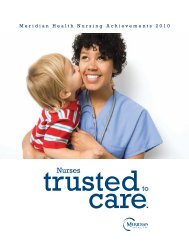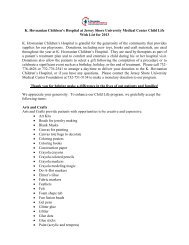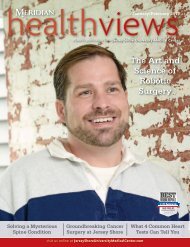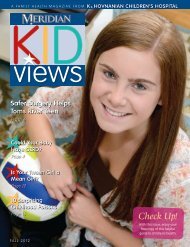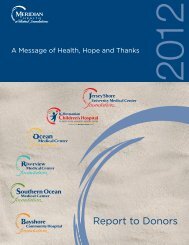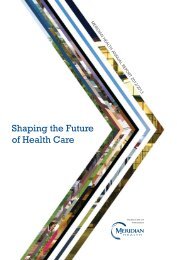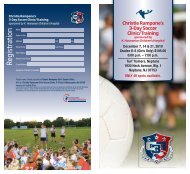May/JUNe 2013 - Jersey Shore Medical Center
May/JUNe 2013 - Jersey Shore Medical Center
May/JUNe 2013 - Jersey Shore Medical Center
You also want an ePaper? Increase the reach of your titles
YUMPU automatically turns print PDFs into web optimized ePapers that Google loves.
Steps Toward Rehabilitation<br />
Participating in stroke rehabilitation<br />
can help people regain their<br />
independence and relearn skills lost<br />
when a stroke damages part of the<br />
brain. Rehab can involve physical and<br />
occupational therapy and exercises to<br />
help the person control movements<br />
and relearn how to walk, eat, and<br />
dress. After a stroke, many people<br />
may experience problems speaking,<br />
listening, writing, or comprehending<br />
speech, so rehab could entail therapy<br />
for communication disorders.<br />
Speech-language pathologists also<br />
help stroke survivors improve their<br />
ability to swallow.<br />
Rehab can also involve physical<br />
therapy. Therapists can help improve<br />
strength and function in strokeimpaired<br />
limbs, as well as coordination<br />
and balance. Range-of-motion<br />
exercises help patients regain mobility,<br />
but early rehab is essential to recovery.<br />
An occupational therapist can<br />
help stroke survivors relearn everyday<br />
activities, such as eating, going to<br />
Paul J. Gilson, M.D.<br />
Brick • 732-840-4666<br />
Robert J. Terranova, D.O.<br />
Board certified in Neurology<br />
Manahawkin • 609-978-8870<br />
the bathroom, and getting dressed.<br />
And rehabilitation can include<br />
psychological therapy. Depression is<br />
common after a stroke. Talking with a<br />
counselor and participating in support<br />
groups can help.<br />
Keys to Recovery<br />
If you have suffered a stroke, the<br />
degree of recovery varies widely<br />
from person to person, depending<br />
on the amount of damage the stroke<br />
caused and to which part of the<br />
brain. It also depends on the skill<br />
of the rehabilitation team and the<br />
cooperation of friends and family.<br />
“The most important element in<br />
Stephen J. Martino, M.D.<br />
Board certified in<br />
Neurology<br />
Neptune • 732-774-8282<br />
Glenn Forman, M.D.<br />
Board certified in Physical<br />
Medicine and Rehabilitation<br />
Red Bank • 732-741-2313<br />
a stroke rehabilitation program is<br />
focused, repetitive practice that is<br />
carefully directed by a therapist or<br />
therapists,” says Glenn Forman, M.D.,<br />
of Riverview <strong>Medical</strong> <strong>Center</strong>.<br />
Caregivers can best help<br />
stroke patients by meeting them<br />
halfway — allowing them to do as<br />
much as they can on their own before<br />
stepping in. It’s imperative for a<br />
person to work toward independence,<br />
and the only way to relearn the tasks<br />
of daily living is to try to do them.<br />
Grady’s love for bowling — and a<br />
remarkable care team — helped<br />
him fight his way back to<br />
the lanes after a stroke.<br />
Know the Warning<br />
Signs of Stroke<br />
• Sudden numbness or weakness of<br />
the face, arm or leg, especially on<br />
one side of the body<br />
• Sudden confusion, trouble<br />
speaking or understanding<br />
• Sudden trouble seeing in one or<br />
both eyes<br />
• Sudden trouble walking, dizziness,<br />
loss of balance or coordination<br />
• Sudden severe headache with no<br />
known cause<br />
To hear more from our experts, go to<br />
MeridianNeuroscience.com.<br />
Meridian HealthViews • <strong>May</strong>/June <strong>2013</strong><br />
29




